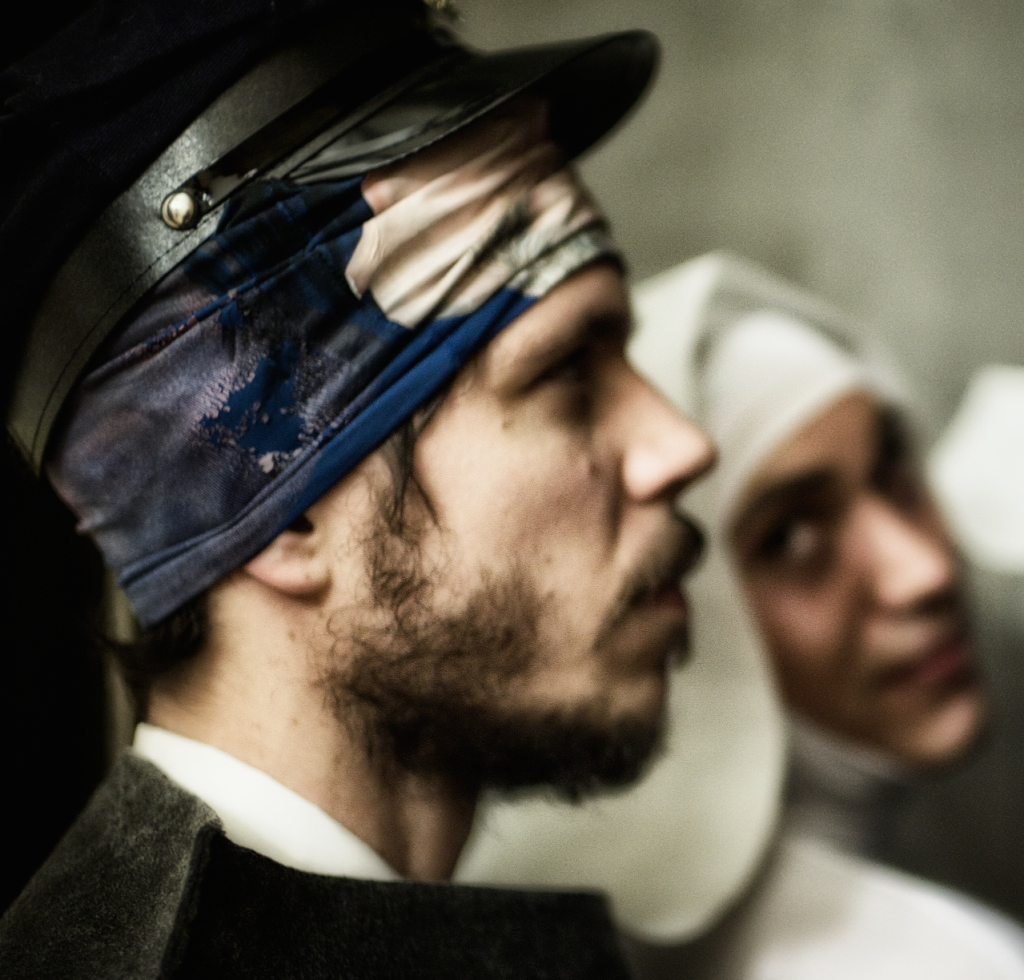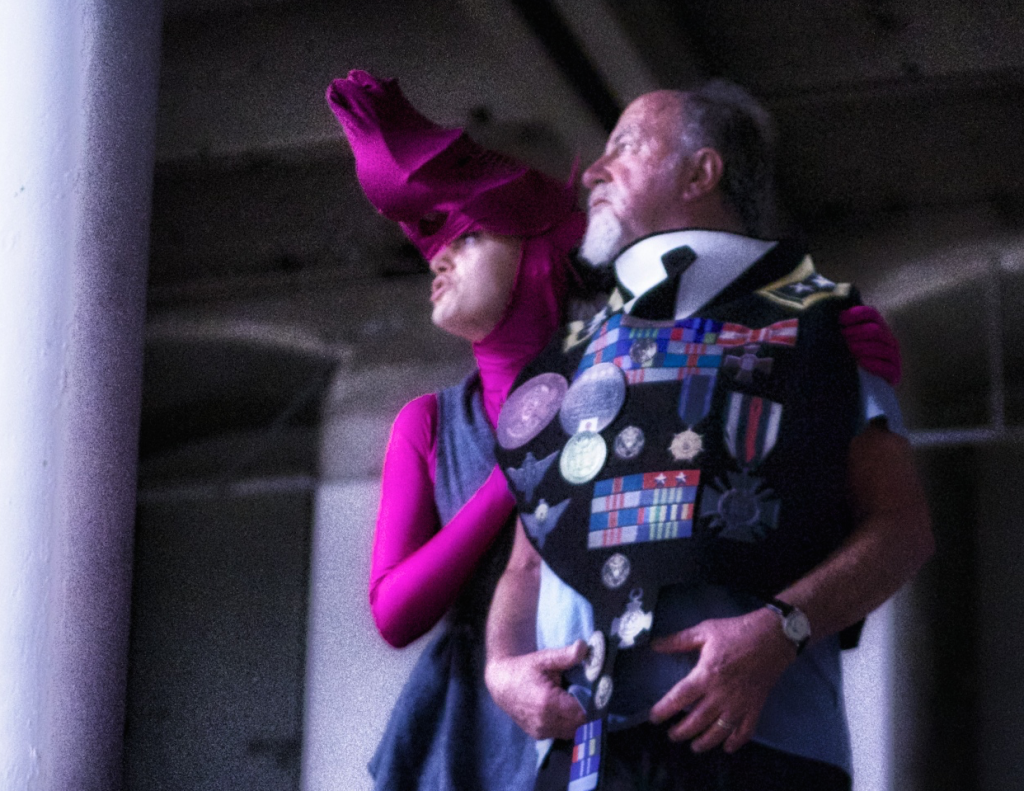
The relationship between signifier and signified, already unsettling due to the complexity of the text, becomes more tenuous by layers of cross-dressing, movement, and physical discomfort in Jean Genet’s The Balcony. It defies easy standards of “like” or “dislike.” The Collected Works company, comprised of several Stanford alumni actors, invite the audience to follow them around a historical space. Viewers become participants, evaluating their roles as spectators in this brothel, a word that also translates “house of illusion” in French. The perambulatory production, housed in San Francisco’s evocative Old Mint Bulding against an art installation and historical coin presses, challenges viewers to rework assumed frames of reference. Inundated with sensory data, partipants were inclined to reel under its weight and spend time processing spectacle rather than story. Onstage relationships in this production, as characters play characters and shift allegiances, are muddy. As a performance piece, The Balcony was a resounding and provocative success. As a presentation of a narrative play, not so much.
The Balcony is set in a brothel. Through the brothel pass, as expected, various nefarious figures. People come to this house of illusions to role-play. Bent on playing out sexual fantasies, several characters take on identities—for example, a priest, an army general— when they enter. Expanding on themes of illusion and power play, the meta-theatrical piece unfolds against a background of revolution. Carmen (Ryan Tacata) and Madame Irma (Val Sinckler) are the masters of the world inside the brothel walls. But, when young revolutionaries start an uprising in the streets of their unnamed city, they are forced to reevaluate where they stand. The microcosmic world of the brothel splinters as the world outside does, too. As the revolutionaries make a series of choices between personal allegiances and the common good, the world of the brothel re-situates itself in a place that only echoes where it stood before.

The first four scenes are presented simultaneously in different rooms of the basement of the Old Mint. In Genet’s own words about his play: “in the first four scenes almost everything is exaggerated.” These scenes, featuring small groups of performers over-acting scenes of assault, self-hatred, and madness, instead of embodying authentic characters, feel more like performance art than theater. The thirty minutes given to navigate through these four scenes, are easily consumed by FOMO as, watching one performance, there were shrieks coming from the room next to it. After these four scenes, the play continues in a more linear manner upstairs. The performative introductory bits allowed the rest of the play to seem raw in contrast. Upstairs, the piece becomes a play.
This production of The Balcony actually stages some scenes on a balcony inside the Old Mint. It’s never quite clear if characters are leaving the brothel in certain scenes, or whether each moment of the play is set inside. A balcony, a structure neither interior nor exterior, is sort of tacked onto a building as neither an entrance nor an exit. The structural integrity of a building does not depend on it, but it adds beauty and dimensionality to a space. Perfect for peeking at the world below without actually stepping into it, a balcony symbolizes the liminal nature of Madame Irma’s brothel.
The performers lead the audience through the various rooms of the Old Mint, using windows, pillars, and tables. The audience huddles in each new space, sitting in movable folding chairs or crouching on the floor. Upstairs, the rooms have high ceilings and elaborate molding. The basement of the Old Mint contains a textile installation set to interact with this performance. Motifs from the art pieces, which include oversized stockings filled with fabric and spools of red thread pulled taut across a cinderblock room, are echoed in the costumes. Characters’ fetishes are also externalized on their vividly imagined costumes: crosses, medals, faces. Blending digital prints and vintage fabrics, the masks feed the idea that characters were in this brothel to put on imagined new roles.
While the visual aspect of this piece was undeniably provocative, in focusing intensely on aesthetics, the directors neglected the truths of the plot. Clearly the creative team had a vision, and that vision looked beautiful. But it felt a bit like a museum put together by stuffy academics. Yes, it’s meaningful and challenging. But it also does not make sense to anyone coming to the piece without an intimate prior knowledge of the content. A production’s first responsibility should be to tell the characters’ stories; this production prioritized the visual elements instead. There’s something to be said for being awed by a spectacle. But, many people are awed by the spectacle of fireworks at Disneyland. The play isn’t gimmicky per se, but there is an unshakeable element of conceit overpowering story.

The lines between performing and acting are not stark under any circumstances. But particularly in a production like this that deals with themes of representation and illusion, it seems that these factors would have been deeply encountered, rather than neglected as symptoms of a weak spot in what was otherwise a streamlined production. Even though the Old Mint space was perfect for a perambulatory piece, it distracts from the story of The Balcony. To take a play already so non-linear and try to map this conceit onto it feels excessive.
Instead of telling a story, this piece smokily gestures at meaning without ever quite drawing conclusions. So I admire it as a piece of visual art. The costumes, the space, the fetishes, wrenched me into a space different from the one I occupy on a typical day. It felt like more of an exhibit than a play, though. Neither interior nor exterior, The Balcony forced audiences to evaluate what their bodies, constantly felt moving around the space, were doing looking in on a spectacle that was, at once, both true and utterly false.
Photo credits: Jamie Lyons
